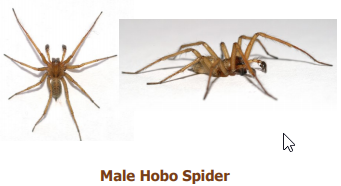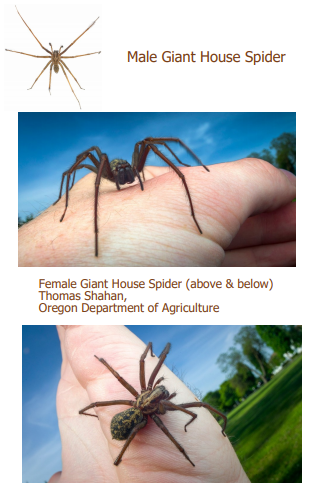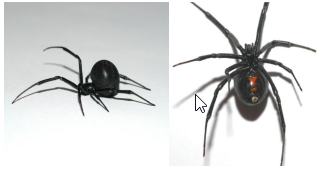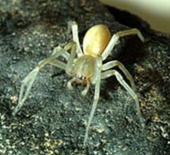More About Oregon Spiders
Hobo, Giant House, Black Widow, and Yellow Sac Spiders
Hobo (Tegenaria agrestis) & giant house spiders (T. gigantea)
The most common spiders submitted for identification at the Oregon Department of Agriculture (ODA) are hobo and giant house spiders. Both spiders were accidentally introduced from Europe. They can be found wherever people live in Oregon. This is because they prefer living in and around homes and because they “hitchhike” on people’s belongings when people move. Most of these spiders are found in the late summer through early fall because the males have emerged from their normal shelters to look for females with which to mate. When these spiders are seen in homes they are usually somewhere on the floor, but they can also be found on walls and ceilings or in cabinets, tubs, and showers. These spiders do not make obvious webs and search for prey at night.

Male Hobo Spider
In Europe, the hobo spider and all other related species are considered harmless. In the northwest US Hobo spiders have gained the reputation as being dangerous. They are often referred to as “aggressive house spiders.” This is not true – they are no more aggressive than any other spider. That misunderstanding is based on a misinterpretation of the scientific name (which is in Latin, as are most scientific names), Tegenaria agrestis, where “agrestis” has been thought to refer to “aggressive.” In Latin, “agrestis” actually refers to “fields” where hobo spiders can often be found.
It is often very difficult to tell hobo spiders and giant house spiders apart. Adult giant house spiders are larger than hobo spiders, especially the males. However, spiders grow gradually so that a young giant house spider may be smaller than an older hobo spider. Also, a poorly fed or “sickly” giant house spider may never grow to full size. Otherwise, these spiders look very similar. Identifiers familiar with these spiders know how to tell them apart, but this often requires examination under a microscope. If you would like to have a spider identified for you bring or mail them to ODA.

The western black widow spider (Latrodectus hesperus)
Black Widow Spider

Black widow spiders are most common in southwestern and eastern Oregon. They are much less so in northwestern Oregon, although they are present, most often on south facing slopes that are rocky and bare of dense trees. On occasion, they are found in houses in the Willamette Valley. For instance, one was brought into the ODA from a house in Salem.
They can also hitchhike when people move from other parts of Oregon to areas where black widows are uncommon. Black widows prefer dark places such as garages, basements, and crawl spaces. They make messy looking webs in tight corners and crevices near the ground or behind and underneath furniture or other items. Once they make a web, they rarely leave it unless disturbed.
Black widows are likely the most harmful spiders in Oregon. Even so, the amount of venom received from a bite is not usually enough to cause a serious reaction in most people. Black widow venom causes very different symptoms than those associated with hobo spider and yellow sac spider bites. It damages the nervous system, leading to symptoms such as abdominal muscle cramps, nausea, profuse perspiration, tremors, fever, labored breathing, and restlessness. These symptoms often last for only a few days. While black widow bites can be very serious, fewer than one out of a hundred of those bitten die. However, anyone who believes they’ve been bitten by a black widow should immediately seek medical attention.
Female black widows are easily identified because they have a distinctive hourglass shaped bright red spot on the underside (not the top of) their abdomen. They also have a very round abdomen and are glossy black, with slender legs. Male black widow spiders are much smaller and differently colored and are rarely encountered. There are several Oregon spiders often found in or around homes that closely resemble female black widows, including the false black widow. However, false black widows are all black and do not have the red spot on the underside of the abdomen.
As with hobo spiders, if you think you’ve been bitten by a black widow, try to save the specimen so an identifier can confirm whether that is so.
Yellow Sac Spiders
There are several hundred species of yellow sac spiders in North America. They are small spiders that are pale yellow to yellow green, with few other markings. Yellow sac spiders don’t make webs but actively search for prey at night. These spiders can be found outside during the day in silken sacs under objects such as planters, firewood, and rocks and on plants in curled up leaves. When they enter homes (usually during cooler weather), they hide in white silken sacs where the ceiling meets the wall or other similar corner. These sacs are also often found along windowsills.
As with hobo spider bites, bites of yellow sac spiders have been reported to cause long term or severe tissue damage. However, also as with hobo spider bites, there have been few confirmed instances of yellow sac spider bites, let alone of those leading to these symptoms. According to one published report, 20 verified cases of yellow sac spider bites in the US and Australia showed no significant tissue damage. In addition, of 39 verified yellow sac spider bites in international literature there was only one case with mild tissue damage from such a bite in Europe. One of ODA’s staff was bitten by a yellow sac spider in Salem. The bite burned and was painful for a short time. A small, reddish welt eventually formed, which mildly itched and lasted for about a week. No further damage or symptoms developed. Of course, other people bitten may have different reactions. As with suspected hobo spider bites, the spider should be saved for identification and, especially if severe symptoms develop, medical attention may be advisable.

Other Oregon spiders
Some other spiders commonly found in and around Oregon homes include grass spiders (species of Agelenopsis), wolf spiders (species of Pardosa), the cellar spider (Pholcus phalangioides), crab or flower spiders (Misumena vatia), the false black widow (Steadota grossa), the folding trapdoor spider (Antrodiatetus pacificus), jumping or zebra spiders (the Phidippus with metallic fangs and Salticus scenicus), the writing spider (Argiope aurantia), the banded garden spider (Argiope trifasciata), and the cross spider (Araneus diadematus). Although some of these are quite large and may resemble injurious venomous spiders (for instance, the false black widow resembles the true black widow and the folding trapdoor spider resembles a small tarantula), none are known to have bites harmful to people. A commonly encountered creature that resembles a spider, but is not, is the harvestman or daddy long legs (Phalangidae). Although these can be quite large and appear threatening, they cannot bite people, even though some people are firmly convinced they are harmful.
For further information please contact: Oregon Department of Agriculture Plant Division www.oregon.gov/ODA/PLANT


Advertisement